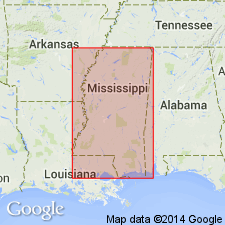
- Usage in publication:
-
- Winona sand member
- Modifications:
-
- Named
- Dominant lithology:
-
- Sand
- AAPG geologic province:
-
- Mid-Gulf Coast basin
Summary:
Winona sand, in northwestern MS, consists of approximately 350 ft of highly glauconitic marine sands and clayey sands, locally abundantly fossiliferous. In eastern MS, the materials change to white and yellowish coarse sand, frequently cross-bedded and nonfossiliferous. Near Meridian, only 75 to 100 ft thick. Especially well developed around Winona, Vaiden, and eastward in adjacent counties. Included in Tallahatta formation as basal member. Conformably underlies Basic claystone. Age is Eocene.
Source: GNU records (USGS DDS-6; Reston GNULEX).
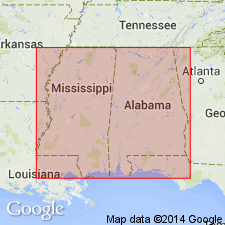
- Usage in publication:
-
- Winona sand member*
- Modifications:
-
- Revised
- AAPG geologic province:
-
- Mid-Gulf Coast basin
Summary:
Winona sand member is redefined to include typical Winona sand of Montgomery Co., and typical "Enterprise marl" of Clarke Co., but to exclude the sands at the base of the Tallahatta formation in Lauderdale Co., MS, which were formerly thought to be same as the much younger sand at Winona. Now assigned as basal member of Lisbon formation.
Source: GNU records (USGS DDS-6; Reston GNULEX).
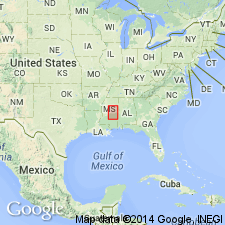
- Usage in publication:
-
- Winona greensand
- Modifications:
-
- Revised
- AAPG geologic province:
-
- Mid-Gulf Coast basin
Thomas, E.P., 1942, The Claiborne: Mississippi Geological Survey Bulletin, no. 48, 96 p.
Summary:
Most authors have considered the Winona greensand to be a member of either the Tallahatta or the Lisbon formation. It is herein raised to formational rank. Overlies Neshoba sand member (new) of Tallahatta formation; underlies Zilpha shale. Thickness commonly 256 ft in general vicinity of type locality.
Source: GNU records (USGS DDS-6; Reston GNULEX).
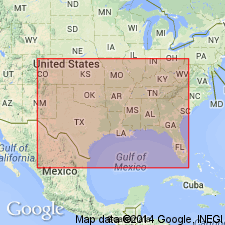
- Usage in publication:
-
- Winona formation*
- Modifications:
-
- Revised
- AAPG geologic province:
-
- Mid-Gulf Coast basin
Summary:
Winona formation of Claiborne group. Correlation chart shows Winona formation in Claiborne group. Underlies Zilpha clay; overlies Tallahatta formation, either Holly Springs sand member, Basic City shale member, or Neshoba sand member. [Age is middle Eocene.]
Source: US geologic names lexicon (USGS Bull. 1200, p. 4266).
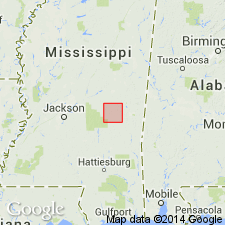
- Usage in publication:
-
- Winona Formation
- Modifications:
-
- Overview
- AAPG geologic province:
-
- Mid-Gulf Coast basin
Summary:
Nomenclature in this report follows Thomas (1942) and Dockery (1981) in classifying Winona as a separate formation within the Claiborne Group. Unit is well exposed in eastern and northeastern Newton Co. At the surface, it is a dark reddish-brown, medium- to fine-grained, poorly sorted, silty, clayey, glauconitic, fossiliferous sand. Locally, glauconite content exceeds 50 percent. Limonitic ironstone beds common. Weathers to a deep reddish-brown, but fresh exposures are a light olive-gray to greenish-gray. Contains abundant molds and casts of bivalves and gastropods. Most common bivalve fossil occurrences include NEMOCARDIUM sp., CRASSATELLA sp., CHLAMYS sp., and CUBITOSTREA sp. Common gastropods are LACINIA ALVEATA (Conrad), CALYPTRAPHORUS sp., and ATHLETA sp. In the subsurface, the Winona is very fine- to very coarse grained, silty, clayey, fossiliferous, glauconitic sand, with calcite cemented layers of glauconitic sandstone and siltstone, interbedded and interlaminated with non-cemented layers. Maximum thickness in Newton Co. occurs in Test Hole A0-1 where unit is 72 ft. Disconformably overlies the Neshoba Sand Member of the Tallahatta Formation and conformably underlies the Zilpha Formation. Winona represents a destructional shelf facies deposited in a marine transgression. Geologic map. Measured section. Stratigraphic column.
Source: GNU records (USGS DDS-6; Reston GNULEX).
For more information, please contact Nancy Stamm, Geologic Names Committee Secretary.
Asterisk (*) indicates published by U.S. Geological Survey authors.
"No current usage" (†) implies that a name has been abandoned or has fallen into disuse. Former usage and, if known, replacement name given in parentheses ( ).
Slash (/) indicates name conflicts with nomenclatural guidelines (CSN, 1933; ACSN, 1961, 1970; NACSN, 1983, 2005, 2021). May be explained within brackets ([ ]).

